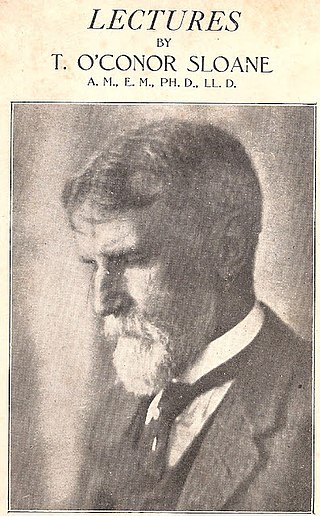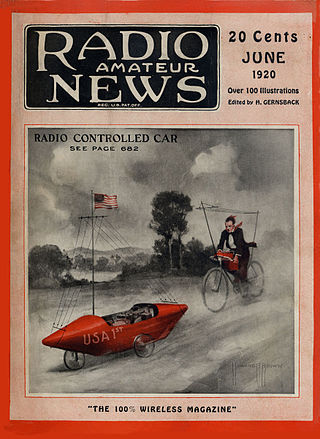
Hugo Gernsback was a Luxembourgish–American editor and magazine publisher, whose publications included the first science fiction magazine, Amazing Stories. His contributions to the genre as publisher were so significant that, along with the novelists H. G. Wells and Jules Verne, he is sometimes called "The Father of Science Fiction". In his honor, annual awards presented at the World Science Fiction Convention are named the "Hugos".

Amazing Stories is an American science fiction magazine launched in April 1926 by Hugo Gernsback's Experimenter Publishing. It was the first magazine devoted solely to science fiction. Science fiction stories had made regular appearances in other magazines, including some published by Gernsback, but Amazing helped define and launch a new genre of pulp fiction.

Thomas O'Conor Sloane was an American scientist, inventor, author, editor, educator, and linguist, perhaps best known for writing The Standard Electrical Dictionary and as the editor of Scientific American, from 1886 to 1896 and the first science fiction magazine, Amazing Stories, from 1929 to 1938.

Popular Science is an American digital magazine carrying popular science content, which refers to articles for the general reader on science and technology subjects. Popular Science has won over 58 awards, including the American Society of Magazine Editors awards for its journalistic excellence in 2003, 2004, and 2019. With roots beginning in 1872, Popular Science has been translated into over 30 languages and is distributed to at least 45 countries.

Modern Electrics was a technical magazine for the amateur radio experimenter. The magazine existed between 1908 and 1914.
The Amalgamated Press (AP) was a British newspaper and magazine publishing company founded by journalist and entrepreneur Alfred Harmsworth (1865–1922) in 1901, gathering his many publishing ventures together under one banner. At one point the largest publishing company in the world, AP employed writers such as Arthur Mee, John Alexander Hammerton, Edwy Searles Brooks, and Charles Hamilton. Its subsidiary, the Educational Book Company, published The Harmsworth Self-Educator, The Children's Encyclopædia, and Harmsworth's Universal Encyclopaedia. The company's newspapers included the Daily Mail, the Daily Mirror, The Evening News, The Observer, and The Times. At its height, AP published over 70 magazines and operated three large printing works and paper mills in South London.

Edwin James Houston was an American electrical engineer, academic, businessman, inventor and writer.

Lippincott's Monthly Magazine was a 19th-century literary magazine published in Philadelphia from 1868 to 1915, when it relocated to New York to become McBride's Magazine. It merged with Scribner's Magazine in 1916.
Alfred Powell 'Skipper' Morgan (1889–1972) was an electrical engineer, inventor of radio and mechanical devices, and author of technical and children's books from the U.S. state of New Jersey.

Experimenter Publishing was an American media company founded by Hugo Gernsback in 1915. The first magazine was The Electrical Experimenter (1913–1931) and the most notable magazines were Radio News (1919–1985) and Amazing Stories (1926–2005). Their radio station, WRNY, began broadcasting experimental television in 1928. In early 1929 the company was forced into bankruptcy and the Gernsback brothers lost control of Experimenter Publishing. The magazines did not miss an issue and were quickly sold to another publisher. The Gernsbacks promptly started new magazines to compete with their former ones.

Radio News was an American monthly technology magazine published from 1919 to 1971. The magazine was started by Hugo Gernsback as a magazine for amateur radio enthusiasts, but it evolved to cover all the technical aspects to radio and electronics. In 1929 a bankruptcy forced the sale of Gernsback's publishing company to B. A. Mackinnon. In 1938 Ziff-Davis Publishing acquired the magazines.
The Electrician, published in London from 1861–1863 and 1878–1952, was the one of the earliest and foremost electrical engineering periodicals and scientific journals. It was published in two series: The original Electrician was published for three years from 1861–1863. After a fifteen year gap, a new series of the Electrician was in print for 72 years from 1878–1952. The Electrician is currently remembered as the publisher of Oliver Heaviside's works, in particular the first publication of the telegrapher's equations, still in wide use for radio engineering.

Science-Fiction Plus was an American science fiction magazine published by Hugo Gernsback for seven issues in 1953. In 1926, Gernsback had launched Amazing Stories, the first science fiction magazine, but he had not been involved in the genre since 1936, when he sold Wonder Stories. Science-Fiction Plus was initially in slick format, meaning that it was large-size and printed on glossy paper. Gernsback had always believed in the educational power of science fiction, and he continued to advocate his views in the new magazine's editorials. The managing editor, Sam Moskowitz, had been a reader of the early pulp magazines, and published many writers who had been popular before World War II, such as Raymond Z. Gallun, Eando Binder, and Harry Bates. Combined with Gernsback's earnest editorials, the use of these early writers gave the magazine an anachronistic feel.

Oliver Blackburn Shallenberger was an American electrical engineer and inventor. He is associated with electrical inventions related to alternating current. He is most noted for inventing the first successful alternating current (AC) electrical meter, the forerunner of the modern electric meter. This was critical to general acceptance of AC power.

Radio-Electronics was an American electronics magazine that was published under various titles from 1929 to 2003. Hugo Gernsback, sometimes called the father of science fiction, started it as Radio-Craft in July 1929. The title was changed to Radio-Electronics in October 1948 and again to Electronics Now in July 1992. In January 2000 it was merged with Gernsback's Popular Electronics to become Poptronics. Gernsback Publications ceased operations in December 2002 and the January 2003 issue was the last. Over the years, Radio-Electronics featured audio, radio, television and computer technology. The most notable articles were the TV Typewriter and the Mark-8 computer. These two issues are considered milestones in the home computer revolution.

The Moving Picture World was an influential early trade journal for the American film industry, from 1907 to 1927. An industry powerhouse at its height, Moving Picture World frequently reiterated its independence from the film studios.

The Motion Picture News was an American film industry trade paper published from 1913 to 1930.

Grace Mann Brown was an American writer and spiritual leader. Her work was related to the New Thought Movement, Divine Science and Christian Science. Much of her work focused on spirituality, metaphysics, mysticism, esoteric and occult sciences.

Engineering Magazine was an American illustrated monthly magazine devoted to industrial progress, first published in 1891. The periodical was published under this title until October 1916. Sequentially from Nov. 1916 to 1927 it was published as Industrial Management.






























